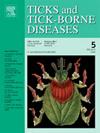三种致病病原体在鸟媒黑腿蜱中的流行变化:狭义伯氏疏螺旋体、嗜吞噬细胞无形体和微小巴贝斯虫
IF 3.4
2区 医学
Q2 INFECTIOUS DISEASES
引用次数: 0
摘要
狭义伯氏疏螺旋体、嗜吞噬细胞无形体和微小巴贝斯虫是美国医学和兽医关注的常见蜱传病原体,由黑腿蜱(肩胛硬蜱)传播。蜱虫及其病原体的活动范围取决于包括鸟类在内的脊椎动物宿主的活动。飞行使鸟类具有高度的机动性——使它们有可能迅速扩大蜱虫及其病原体的范围,从而影响人类、野生动物和牲畜接触蜱虫传播疾病的风险。我们调查了狭义伯氏疏螺旋体、嗜吞噬胞杆菌和嗜吞噬胞杆菌的流行情况。近十年来鸟载褐飞虱幼虫中微虫的研究进展,以及特定鸟类对其在环境中维持的相对重要性。利用qPCR技术对2010年和2019年从鸟类身上采集的肿胀的肩胛骨棘球绦虫幼虫进行病原体检测。严感伯氏疏螺旋体、嗜吞噬细胞疏螺旋体和嗜吞噬细胞疏螺旋体的年患病率。microti在不同年份之间有显著差异(P <;0.05),从2010年的17.2%、9.7%和0%分别变化到2019年的33.8%、2.9%和5.1%。鸟类对伯氏疏螺旋体的感染有显著的预测作用,美洲知更鸟(Turdus migratorius)、卡罗莱纳鹪鹩(Thryothorus ludovicianus)和北方鹪鹩(Troglodytes aedon)产生的蜱感染率较高。候鸟和留鸟物种可能以各种方式在蜱传病原体的环境维持及其范围扩大中发挥重要作用,需要进一步评估这些病原体-媒介-宿主相互作用。本文章由计算机程序翻译,如有差异,请以英文原文为准。
Changes in the prevalence of three disease-causing pathogens in bird-borne blacklegged ticks: Borrelia burgdorferi sensu stricto, Anaplasma phagocytophilum, and Babesia microti
Borrelia burgdorferi sensu stricto, Anaplasma phagocytophilum, and Babesia microti are common tick-borne pathogens of medical and veterinary concern in the United States and are transmitted by the blacklegged tick (Ixodes scapularis). The range expansion of ticks and their pathogens depends on the movements of vertebrate hosts, including birds. Flight grants birds high mobility – giving them the potential to rapidly expand the range of ticks and their pathogens, thus impacting human, wildlife, and livestock risk of exposure to tick-borne diseases. We examined the prevalence of B. burgdorferi sensu stricto, A. phagocytophilum, and Ba. microti in bird-borne I. scapularis larvae over the last decade and the relative importance of specific bird species in their maintenance in the environment. Engorged I. scapularis larvae collected from birds in 2010 and 2019 were tested for pathogens using qPCR. Annual prevalences of B. burgdorferi sensu stricto, A. phagocytophilum, and Ba. microti significantly differed between years (P < 0.05), changing from 17.2 %, 9.7 %, and 0 % in 2010 to 33.8 %, 2.9 %, and 5.1 % in 2019, respectively. Bird species significantly predicted B. burgdorferi sensu stricto infection with the American robin (Turdus migratorius), Carolina wren (Thryothorus ludovicianus), and northern house wren (Troglodytes aedon) yielding ticks with high infection prevalences. Migratory and resident bird species may play important roles in the environmental maintenance of tick-borne pathogens and their range expansion in various ways, and further assessments of these pathogen-vector-host interactions are needed.
求助全文
通过发布文献求助,成功后即可免费获取论文全文。
去求助
来源期刊

Ticks and Tick-borne Diseases
INFECTIOUS DISEASES-MICROBIOLOGY
CiteScore
6.90
自引率
12.50%
发文量
185
审稿时长
6-12 weeks
期刊介绍:
Ticks and Tick-borne Diseases is an international, peer-reviewed scientific journal. It publishes original research papers, short communications, state-of-the-art mini-reviews, letters to the editor, clinical-case studies, announcements of pertinent international meetings, and editorials.
The journal covers a broad spectrum and brings together various disciplines, for example, zoology, microbiology, molecular biology, genetics, mathematical modelling, veterinary and human medicine. Multidisciplinary approaches and the use of conventional and novel methods/methodologies (in the field and in the laboratory) are crucial for deeper understanding of the natural processes and human behaviour/activities that result in human or animal diseases and in economic effects of ticks and tick-borne pathogens. Such understanding is essential for management of tick populations and tick-borne diseases in an effective and environmentally acceptable manner.
 求助内容:
求助内容: 应助结果提醒方式:
应助结果提醒方式:


